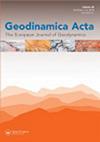利用地貌指标分析安纳托利亚西部霍纳兹断裂的构造特征及其区域意义
IF 1.5
Q1 Earth and Planetary Sciences
引用次数: 47
摘要
Honaz Dağı (Honaz Mountain, Denizli)是安纳托利亚西部的最高峰(2517米),代表了安纳托利亚西部伸展省的Denizli地堑Horst系统的南缘。霍纳兹断裂是一条宽2 km、长15 km的北向弧形倾滑板状正断层,位于霍纳兹Dağı北缘,形成于早第四纪以来的北向伸展构造体制下。本研究使用实地调查和基于数字高程模型的地貌分析来确定Honaz断层的运动行为。形态测量指标,如轴向河流剖面、流域几何形状、三角形切面、山前轮廓模式和弯曲度,记录了活动构造对霍纳兹断层及其周围地区演化的影响,以及谷底宽高比和山前面特征。这些新构造指标表明霍那士断裂带构造活动程度较高,表明霍那士Dağı第四纪景观演化受构造和气候相关侵蚀作用的支配。综合地貌指标和野外资料表明,所分析的霍纳兹断层倾滑正断层段呈线状且高度活跃,可能产生6.7级地震。沿着山前的断层轨迹的形态计量学分析显示,最小滑移率为0.15 -。霍纳兹断层的滑动率为38毫米/年,这与爱琴海地区活跃的正断层的滑动率相似。本文章由计算机程序翻译,如有差异,请以英文原文为准。
Tectonic analysis of the Honaz Fault (western Anatolia) using geomorphic indices and the regional implications
Honaz Dağı (Honaz Mountain, Denizli) is the highest peak in western Anatolia (2517 m) and represents the southern margin of the Denizli Graben Horst System in the western Anatolia Extensional Province. Honaz Fault is a 2-km-wide, 15-km-long northward arc-shaped dip-slip listric normal fault that bounds the northern margin of Honaz Dağı, and has been formed under an N–S-trending extensional tectonic regime since the early Quaternary. This study uses fieldwork and digital elevation model-based geomorphic analysis to identify the kinematic behaviour of the Honaz Fault. Morphometric indices, such as axial river profiles, drainage basin geometries, triangular facets, mountain‐front lineament patterns and sinuosities, document the impact of active tectonics on the evolution of the Honaz Fault and its surroundings, as do valley floor width-to-height ratios and mountain front facet characteristics. These neotectonic indices suggest a relatively high degree of tectonic activity along the Honaz Fault, and suggest that the Quaternary landscape evolution of Honaz Dağı was governed by structural and climate-related erosional processes. Combined geomorphic indices and field data suggest that the analysed dip-slip normal fault segments of the Honaz Fault are linear and highly active, and could generate earthquakes with magnitudes of 6.7. Morphometric analyses of the fault trace along the mountain front yield minimum slip rates of .15–.38 mm/y for the Honaz Fault, which are similar to slip rates calculated for active normal faults in the Aegean region.
求助全文
通过发布文献求助,成功后即可免费获取论文全文。
去求助
来源期刊

Geodinamica Acta
地学-地球科学综合
CiteScore
4.50
自引率
0.00%
发文量
0
审稿时长
25 weeks
期刊介绍:
Geodinamica Acta provides an international and interdisciplinary forum for the publication of results of recent research dealing with both internal and external geodynamics. Its aims to promote discussion between the various disciplines that work on the dynamics of the lithosphere and hydrosphere. There are no constraints over themes, provided the main thrust of the paper relates to Earth''s internal and external geodynamics. The Journal encourages the submission of papers in all fields of earth sciences, such as biostratigraphy, geochemistry, geochronology and thermochronology, geohazards and their societal impacts, geomorphology, geophysics, glaciology, igneous and metamorphic petrology, magmatism, marine geology, metamorphism, mineral-deposits and energy resources, mineralogy, orogeny, palaeoclimatology, palaeoecology, paleoceanograpgy, palaeontology, petroleum geology, sedimentology, seismology and earthquakes, stratigraphy, structural geology, surface processes, tectonics (neoteoctonic, plate tectonics, seismo-tectonics, Active tectonics) and volcanism.
Geodinamica Acta publishes high quality, peer-reviewed original and timely scientific papers, comprehensive review articles on hot topics of current interest, rapid communications relating to a significant advance in the earth sciences with broad interest, and discussions of papers that have already appeared in recent issues of the journal. Book reviews are also included. Submitted papers must have international appeal and regional implications; they should present work that would be of interest to many different specialists. Geographic coverage is global and work on any part of the world is considered. The Journal also publishes thematic sets of papers on topical aspects of earth sciences or special issues of selected papers from conferences.
 求助内容:
求助内容: 应助结果提醒方式:
应助结果提醒方式:


